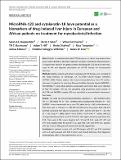Files in this item
MicroRNA-122 and cytokeratin-18 have potential as a biomarkers of drug-induced liver injury in European and African patients on treatment for mycobacterial infection
Item metadata
| dc.contributor.author | Rupprechter, Sarah A.E. | |
| dc.contributor.author | Sloan, Derek J. | |
| dc.contributor.author | Oosthuyzen, Wilna | |
| dc.contributor.author | Bachmann, Till T. | |
| dc.contributor.author | Hill, Adam T. | |
| dc.contributor.author | Dhaliwal, Kevin | |
| dc.contributor.author | Templeton, Kate | |
| dc.contributor.author | Matovu, Joshua | |
| dc.contributor.author | Sekaggya-Wiltshire, Christine | |
| dc.contributor.author | Dear, James W. | |
| dc.date.accessioned | 2021-02-11T16:30:06Z | |
| dc.date.available | 2021-02-11T16:30:06Z | |
| dc.date.issued | 2021-01-26 | |
| dc.identifier | 272466048 | |
| dc.identifier | feb0c90c-e54f-4619-b866-1cadb2de8a33 | |
| dc.identifier | 85099918819 | |
| dc.identifier | 000611864400001 | |
| dc.identifier.citation | Rupprechter , S A E , Sloan , D J , Oosthuyzen , W , Bachmann , T T , Hill , A T , Dhaliwal , K , Templeton , K , Matovu , J , Sekaggya-Wiltshire , C & Dear , J W 2021 , ' MicroRNA-122 and cytokeratin-18 have potential as a biomarkers of drug-induced liver injury in European and African patients on treatment for mycobacterial infection ' , British Journal of Clinical Pharmacology , vol. Early View . https://doi.org/10.1111/bcp.14736 | en |
| dc.identifier.issn | 0306-5251 | |
| dc.identifier.other | RIS: urn:D677E740F8E73C7955B83304675483A5 | |
| dc.identifier.other | ORCID: /0000-0002-7888-5449/work/88731241 | |
| dc.identifier.uri | https://hdl.handle.net/10023/21414 | |
| dc.description | Funding: Sarah Rupprechter was funded by the UK Medical Research Council via the Doctoral Training Programme Grant in Precision Medicine at the University of Edinburgh. | en |
| dc.description.abstract | Aims Patients on antituberculosis (anti‐TB) therapy are at risk of drug‐induced liver injury (DILI). MicroRNA‐122 (miR‐122) and cytokeratin‐18 (K18) are DILI biomarkers. To explore their utility in this global context, circulating miR‐122 and K18 were measured in UK and Ugandan populations on anti‐TB therapy for mycobacterial infection. Methods Healthy subjects and patients receiving anti‐TB therapy were recruited at the Royal Infirmary of Edinburgh, UK (ALISTER—ClinicalTrials.gov Identifier: NCT03211208). African patients with human immunodeficiency virus–TB coinfection were recruited at the Infectious Diseases Institute, Kampala, Uganda (SAEFRIF—NCT03982277). Serial blood samples, demographic and clinical data were collected. In ALISTER samples, MiR‐122 was quantified using polymerase chain reaction. In ALISTER and SAEFRIF samples, K18 was quantified by enzyme‐linked immunosorbent assay. Results The study had 235 participants (healthy volunteers [n = 28]; ALISTER: active TB [n = 30], latent TB [n = 88], nontuberculous mycobacterial infection [n = 25]; SAEFRIF: human immunodeficiency virus‐TB coinfection [n = 64]). In the absence of DILI, there was no difference in miR‐122 and K18 across the groups. Both miR‐122 and K18 correlated with alanine transaminase (ALT) activity (miR‐122: R = .52, 95%CI = 0.42–0.61, P < .0001. K18: R =0.42, 95%CI = 0.34–0.49, P < .0001). miR‐122 distinguished those patients with ALT>50 U/L with higher sensitivity/specificity than K18. There were 2 DILI cases: baseline ALT, 18 and 28 IU/L, peak ALT 431 and 194 IU/L; baseline K18, 58 and 219 U/L, peak K18 1247 and 3490 U/L; baseline miR‐122 4 and 17 fM, peak miR‐122 60 and 336 fM, respectively. Conclusion In patients treated with anti‐TB therapy, miR‐122 and K18 correlated with ALT and increased with DILI. Further work should determine their diagnostic and prognostic utility in this global context‐of‐use. | |
| dc.format.extent | 12 | |
| dc.format.extent | 1799932 | |
| dc.language.iso | eng | |
| dc.relation.ispartof | British Journal of Clinical Pharmacology | en |
| dc.subject | Cytokeratin-18 | en |
| dc.subject | Drug-induced liver injury | en |
| dc.subject | microRNA-122 | en |
| dc.subject | Tuberculosis | en |
| dc.subject | QR Microbiology | en |
| dc.subject | RM Therapeutics. Pharmacology | en |
| dc.subject | DAS | en |
| dc.subject | SDG 3 - Good Health and Well-being | en |
| dc.subject.lcc | QR | en |
| dc.subject.lcc | RM | en |
| dc.title | MicroRNA-122 and cytokeratin-18 have potential as a biomarkers of drug-induced liver injury in European and African patients on treatment for mycobacterial infection | en |
| dc.type | Journal article | en |
| dc.contributor.institution | University of St Andrews. School of Medicine | en |
| dc.contributor.institution | University of St Andrews. Infection and Global Health Division | en |
| dc.identifier.doi | 10.1111/bcp.14736 | |
| dc.description.status | Peer reviewed | en |
This item appears in the following Collection(s)
Items in the St Andrews Research Repository are protected by copyright, with all rights reserved, unless otherwise indicated.

